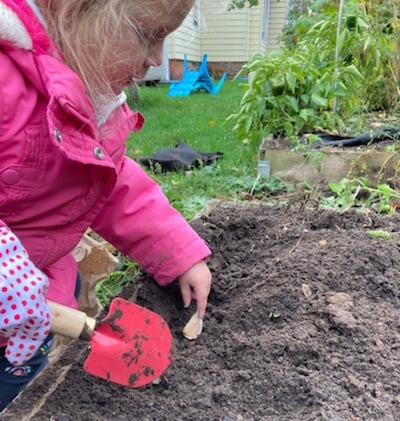Not too late for fall garden work to benefit spring bloom

Garlic is planted in a raised bed.
Photo and articles courtesy of Katie Oakes, Horticulture Educator for the Cornell Cooperative Extension in Orleans County
KNOWLESVILLE – As winter looms nearer, now is a great time to accomplish some tasks outside that will benefit next year’s growing season in various ways.
Fall is the best time to plant spring flowering bulbs for a colorful reward early next year. Those first blooms of spring are a welcome sight after the snow and gray of a long winter. There are many different kinds of flowering spring bulbs – from more common ones like daffodils and tulips to lesser known varieties like Scillas and aconites.

A just planted garlic clove should make an appearance in the spring.
Their specific care and site needs can vary, but most varieties require mostly sunny sites with light, well-drained soil. Spring-blooming bulbs come back year after year, so be sure to select a site with long-term potential. Most bulbs should be planted at a depth of about two to three times the length of the bulb.
Orientation of the bulbs while planting is important, usually the narrower, pointy end of the bulb goes up while the broader base goes down. Often there will be remnants of roots on the base of the bulb to give a good indicator of which direction to plant.
Bulbs are most aesthetically pleasing when planted in groups rather than singly. Cover with soil, water to settle the bulbs in, and wait for spring! Often, the tips of the bulb foliage can be seen poking through the soil even as early as January and February. Don’t worry, though – in almost all cases, they will not be harmed by subsequent freezing temperatures.
Garlic is also typically planted in the fall and is one of the easiest vegetable crops you can grow! Purchase heads from a local grower, through your farmers market, or from a roadside stand. Heads purchased from a commercial grocery store are usually not recommended for planting –they could be harboring viral, fungal or bacterial diseases, or they may have been treated to discourage sprouting.
Separate each clove from the head, leave the papery husk, and plant 4-6” apart in a sunny location with well-drained soil. Garlic can benefit from a fertilizer application, but if your soil is fertile and high in organic matter, it may not be necessary.
Garlic comes in both soft-neck and hard-neck varieties (“Elephant Garlic” is actually a type of leek, not a true garlic). The soft-neck and hard-neck varieties have some differences in the final crop (soft-neck varieties have stronger flavors and store better, but are less cold-hardy), but planting recommendations are the same.

These grape hyacinth bulbs are ready to go in the ground.
The garlic cloves will send out roots over the late fall and winter, then shoot and bulb development begins in the spring. Harvest is usually done in July or August. Aside from weeding to keep the planting clear, there’s not a lot of maintenance required to grow great garlic!

Leaves are in abundant supply this time of the year. They can provide beneficial cover for insects during the winter.
Gardeners often want to do one final clean-up in their growing beds before winter sets in. This is an excellent idea for any diseased plant material that may have been present during the growing season.
The best course of action to prevent overwintering and reinfection of diseases is to remove and destroy diseased plant material as soon as possible. Certain diseases can remain even after a cold winter, so it’s important not to leave the affected leaves/fruit in the garden or even in the compost.
Research shows, however, that it is more beneficial to the ecosystem as a whole to leave behind many of the spent flower stalks and fallen leaves that gardeners usually want to clear out and clean up.
Those spent flower seed heads can provide forage and food for winter birds, and the hollow stems of native plants can offer shelter and nesting sites for overwintering native bees. Nesting bumblebees burrow underground, so leaving some ground exposed and un-mulched can provide a welcome refuge for them.
Many butterfly species rely on fallen leaves for hibernating or for their caterpillars to use during chrysalis formation. Leaves can also be a great addition of brown material for compost piles and can serve as excellent (free!) mulch for garden beds.
So instead of putting bagged leaves at the curb, consider leaving a leaf pile in a corner of your yard. Your garden will be a haven for beneficial insects and animals!
For more timely gardening tips or to ask specific insect or plant disease questions, feel free to reach out to Orleans County Cornell Cooperative Extension Master Gardeners or Horticulture Educator Katie Oakes at 585-798-4265 ext. 125 or klo54@cornell.edu.
You’re here checking the site, so you know: Orleans Hub is a vital resource for our community. Day in and day out, we share information and insights that matter to those who live and work in the towns, villages and hamlets of our county. Local advertisers help make the Hub possible, and so can you.
We do not charge for subscriptions, we do not have pop-up ads or ask you to do surveys to access the news.Donate today to keep Orleans Hub healthy and accessible to all. Thank you!
A check can be mailed to Orleans Hub, P.O. Box 231, Albion, NY 14411.










































































